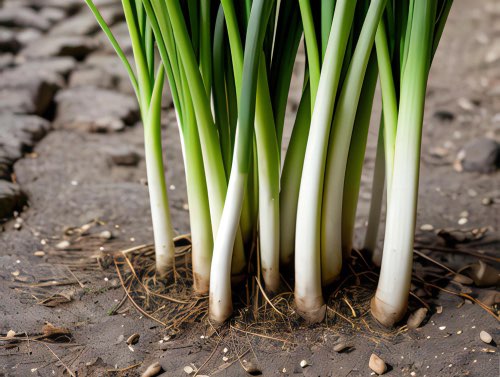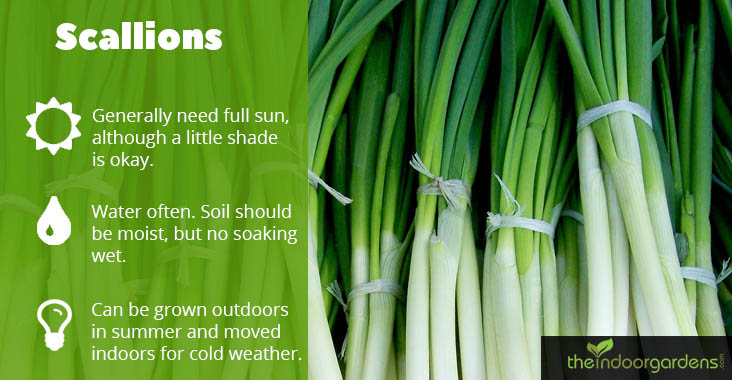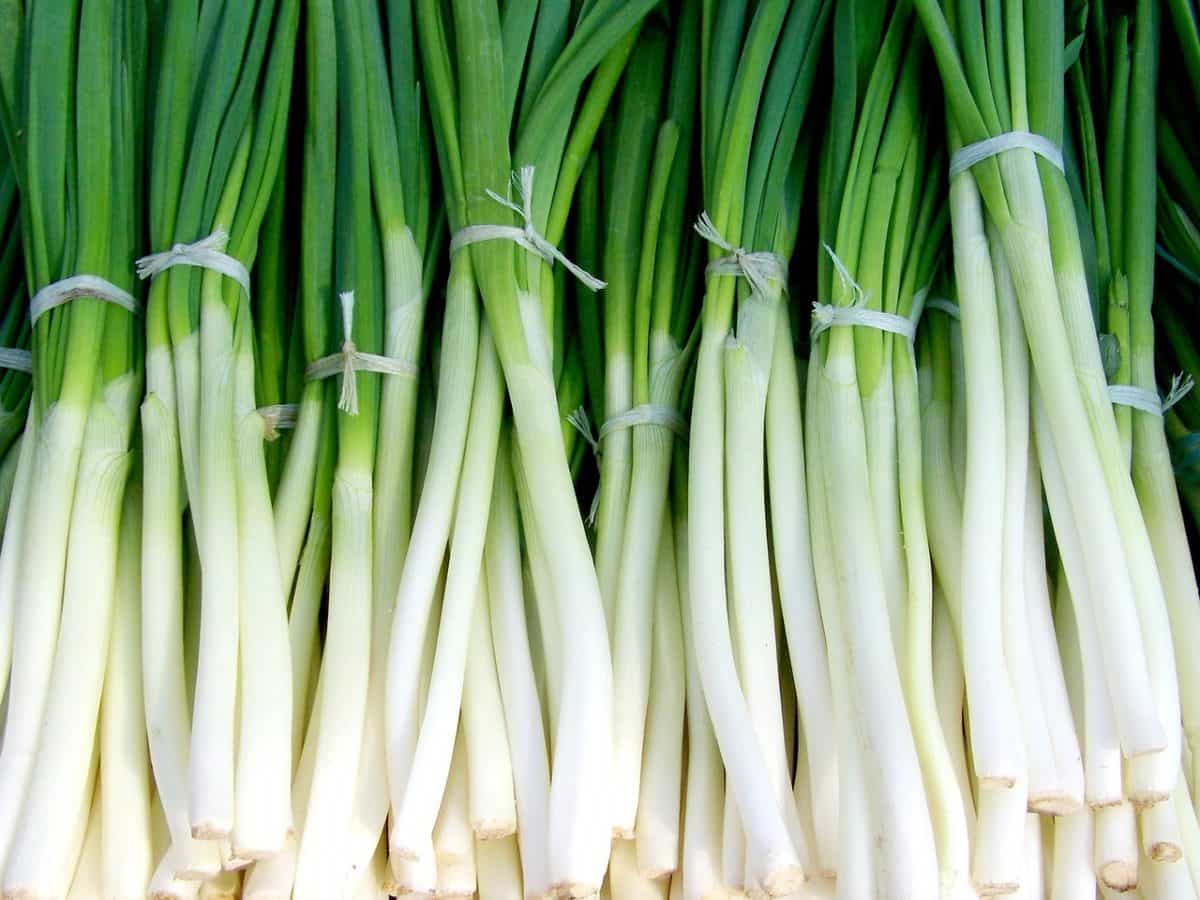If you’re an avid cook, you probably know the benefits of incorporating the pungent stalks of scallions (often called green onions) into your food. And if you’re not, you’ll be surprised by the burst of flavor and versatility the green onions can add to your dish. To make things better for the gardener in all of us, it’s very easy to learn to grow scallions indoors.
In addition to taking the taste of your dish to a whole new dimension, scallions are rich in B-complex vitamins and minerals such as iron, copper, magnesium, and calcium. Simply put, they are great for your health.
Let’s jump right in, and discover how easy it can be to grow your very own batch of scallions indoors!
Scallions Vs Green Onions?
The first thing to get out of the way is to look is the difference between a scallion and a green onion. In reality, there is none, they are actually the same plant. Some technical/scientific definitions do differ, but for most home use the two are the same. A recipe that calls for one can usually be safely substituted with the other. Throughout this article, we’ll refer to them as scallions, but know that the care for each is the same and you’ll get that same great flavor from each.
Soil & Container
Like other onions, scallions have a fairly shallow root system and therefore require consistently moist soil. That said, you don’t want the soil soaking in water. Your best bet is to choose a nutrient-rich, well-draining potting soil. Then, add a few inches of small rocks or pebbles to the bottom of the container to promote good drainage.
Generally, using clay pots is going to be perfectly fine. These not only help to prevent over-watering but are also very cheap and easy to obtain. A wide variety of other containers will also work fine. Scallions and green onions grown inside are quite hardy and will do well in a variety of containers if taken proper care of.
They can also be easily grown in a variety of container sizes. You want it to be at least 6” deep, and at least the same width. Any container you do use should also have drainage holes to promote proper drainage. This gives you a lot of options, you can grow them in large pots for a bigger harvest, or conserve space and use small windowsill pots.
Planting Your Scallions
When first starting to grow scallions there are three main ways to do so. They are seedlings, seeds, and cuttings. Let’s briefly look at each.
Starting With Seedlings.
The first is to start with a seedling from a nursery or hardware store. This is the easiest route, and also the quickest if you’re looking to cook with the veggie; you’re starting with a few week head start over seeds.
Prepare your pot and soil as noted above, then gently move your seedling to its new home. Give it a healthy dose of water and place it in a sunny spot to help it survive the transplant process. After that, follow the normal care as detailed below.
Starting With Seeds
The next option is using seeds. To start with seeds, place them about 1/2″ deep and cover them with soil. You can clump them up to start, but once they start to sprout thin them out until there is about 4-6″ between each plant. Scallions germinate fairly quickly and you should see them start to sprout within 7-14 days after planting. During this period it’s important to keep the soil moist. If the soil dries out too much then it can increase the time this process takes.
Prior to germination, you can cover the container with plastic wrap. This seals in the moisture, and keeps the humidity level high around the plant. If you’re looking to grow a lot of scallions, starting with a seed tray is a good option.
Starting With Cuttings
The last option, and one that is quicker than seeds, is to start with leftover scraps. Simply save the bottom 3-4″ of a store-bought scallion and re-use it!
There are two options, either plant it much like a seed roughly 1/2″ deep or leave it in a small glass of water in bright sun. Either method will work, although gardeners will typically have their preference and will swear by one or the other. In both cases, it takes 1-2 weeks to produce a full-grown plant. This process can easily be repeated to always have fresh scallions and green onions ready to use!
Important to note that the rest of this guide will focus on the soil growing variety. The only other important thing to keep in mind for the variety grown in a cup of water is sunlight needs. That, and you should also change out the water weekly to prevent bacteria and fungal growth.

Tip
If replanting a store-bought green onion then you’ll typically be able to do so 4-5 times before you’ll need to change plants.
Sunlight
Scallions are quite interesting in that they can grow in both full and low-light conditions. For best results, place them in a bright, sunny spot that receives 6-8 hours of sunlight per day.
If that’s not possible, however, scallions will be perfectly happy to grow in lower light conditions. This will not affect the quality of the plant but will slow down its growth.
Bright light will yield harvestable plants in the shortest time, while a more shady location will still produce harvestable plants just in a longer time frame. This makes it super easy to grow scallions indoors as they are one of the few veggies that can grow in lower light.
You also have the option to use grow lights. Once again, you can go a bit lower in terms of hours of light but try to hit about 8-10 for optimal growth.
Culinary Uses
Green onions are frequently used as a topping for salads, soups, pasta, and pretty much any other dish you can think of. This makes them perfect for a garden as you can quickly snip off a little to finish your meals. Due to their fast growth, you can do this fairly often without harming the plant. The entire plant is edible, though there is a slight flavor change from the top green parts to the bottom white ones. Some recipes may call for one or the other depending on taste.
Watering Scallions
As germination is highly dependent on the moisture content in the soil it’s best to evenly water your seedlings without drenching or clogging them. You’ll typically want to keep the soil moist, so check every few days for dryness and water when it starts to feel dry to the touch. Once the seeds sprout, you can ease off watering a bit. This also applies to scraps that have been placed in soil, they will need similar water amounts as of a sprouted plant.
Once the plant has sprouted, or if you’re starting with a seedling, keep the soil moist but not soaked. Very similarly, check the top inch or so of the soil, and water once it’s dry. You’ll want to be careful to not overwater to avoid root rot. Scallions do have fairly shallow roots though, so over-watering is not as dangerous here as it is for deeper root plants.
Temperature and Humidity
Scallions typically grow best in the 60-75 degree Fahrenheit range. If that’s normal for your home then you don’t have any more work to do. Do take care, however, to keep them away from any sources of heat or cold like drafy windows or heating vents. These areas can rapidly vary in temperature, and that rapid change can be harmful to your plant.
For humidity, most indoor humidity levels will work perfectly fine. If you notice the ends starting to brown, especially in the winter, then give them a quick mist to help boost humidity.

Tip
Most homes will be perfectly fine temperature and humidity-wise to grow scallions. This is part of what makes them such an easy plant to grow.
Harvesting your Scallions
Once the plant reaches roughly 6″ tall it is ready to harvest. In this respect, you have two options. Firstly, you can pluck the entire plant, all of which is edible. This will however stop the plant from regrowing as the entire plant is used. This does however yield the bulb at the bottom of the plant which has its own unique flavor and is called for in some recipes.

A crop of green onions ready to be harvested.
You can also simply clip off the top couple inches of the plant, and leave the white bottom and root intact. The scallion will continue to grow after this and can be re-harvested every couple of weeks as it regrows. This is the best option for those looking for a continuous supply of the plant.
Even if you don’t plan on using it, keeping your plant trimmed is good for its health. Trimming it every couple of weeks encourages healthy growth.

Grow Scallions Indoors
For those looking for an easy and delicious veggie to grow, learning how to grow scallions indoors is a great option. Scallions are one of the easiest veggies to care for and one of the few that can produce edible plants in low-light conditions. Being able to start from store-bought stalks is also a nice bonus, and means it’s simple to get started growing this delicious plant!
FAQ
What is The Best Way To Grow Scallions Indoors?
The best way to grow scallions indoors is to start with scraps from another plant. Planting the white ends in soil, or placing it in a small glass of water, speeds up the process by which an edible plant can be obtained.
How Much Light Do Scallions Need?
For best results, place the plant in a spot that gets at least 6 hours of bright sunlight. That said, scallions can grow in lower light conditions of only a few hours. In these cases though, it will take longer for the plant to grow, although it will still be edible.
There are Holes In My Green Onions, What Do I Do?
A big problem with green onions is slugs like to chew holes in them. This usually happens when plants are left out on a balcony or porch during warm, wet weather. To stop this simply move the plants indoors during damp days, or take steps to remove the slugs from nearby the plants.
How Long Do Scallions Take To Grow?
From planting to harvest it takes about 10 weeks. This can be shortened by starting with a seedling or cutting. You can also harvest the same plant multiple times depending on how much you take at one time.







